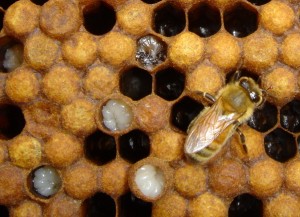June 29
I was covered from head to toe, with every possible opening shut tight by zippers or elastic. This was my first time in a bee suit, and it was making me slightly claustrophobic. Professor John Neeves at UC San Diego had offered to give me a tour of the beehives he keeps in the biological field station on campus. “Just remember to stay calm, and don’t let the mesh mask touch your face.” He told me this as we walked to the back of the large field. This didn’t make me feel any less nervous.
The hives, about sixteen in total, all sat on a couple of long tables in the grass. Each hive was essentially a white box with a secure lid.  A single small hole was where all the bees entered and exited, which was hard to believe because there were hundreds of them surrounding us. “They can become more aggressive once we start opening the hives,” Dr. Neeves warned as he handed me a smoker. It looked like the oil can in The Wizard of Oz. I pointed the nozzle at the top of a hive and puffed out smoke as Dr. Neeves instructed. Bees scampered away from the smoke immediately, but the ones that were buzzing around our heads continued their angry dance, trying to drive us away from their colonies. Once there was enough smoke for Dr. Neeves to pull out a brood frame, I switched out the can for my camera. I zoomed in on the brood frame, which is a wooden frame covered in hexagonal chambers that most people associate with beehives. This is where honey bees store their honey and rear the colony’s larvae.
A single small hole was where all the bees entered and exited, which was hard to believe because there were hundreds of them surrounding us. “They can become more aggressive once we start opening the hives,” Dr. Neeves warned as he handed me a smoker. It looked like the oil can in The Wizard of Oz. I pointed the nozzle at the top of a hive and puffed out smoke as Dr. Neeves instructed. Bees scampered away from the smoke immediately, but the ones that were buzzing around our heads continued their angry dance, trying to drive us away from their colonies. Once there was enough smoke for Dr. Neeves to pull out a brood frame, I switched out the can for my camera. I zoomed in on the brood frame, which is a wooden frame covered in hexagonal chambers that most people associate with beehives. This is where honey bees store their honey and rear the colony’s larvae.
Soon, the sound of buzzing increased from a calm blow dryer to a heavy chainsaw, and I was instructed to start smoking some of the bees out again. “The smoke calms the bees down in two ways,” Dr. Neeves explained as he pulled out another frame. I peeked inside and saw about six frames inside the hive. “The bees associate the smoke with fire and will start eating honey because they think they’ll have to find a new home once their hive has been burned away.  But eating all that honey will make the bees lethargic. Also, the smoke masks the bees’ pheromones, which are a vital form of communication in the hive, especially as a form of sounding an alarm. If they can’t detect each other’s alarm pheromones, the bees become confused.”
But eating all that honey will make the bees lethargic. Also, the smoke masks the bees’ pheromones, which are a vital form of communication in the hive, especially as a form of sounding an alarm. If they can’t detect each other’s alarm pheromones, the bees become confused.”
After learning that, I felt kind of bad for smoking the bees, but I guess it was an effective and fairly harmless method of beekeeping, so I bit my tongue. Once Dr. Neeves found a frame with a healthy-looking brood in it (a large chunk of the comb that are capped with wax to house growing larvae), we closed up the hive and packed up the frame to transport it back to his lab. We walked halfway across the field and blew smoke all over each other one last time to deter any straggling bees before heading in to remove our beekeeping gear.
I was invited into the lab the next day to take photos of the emerging baby bees. It was almost like watching a bird hatching out of its egg. The new bees took their time and used their mandibles (their pincher mouthpart) to bite and tear through the waxy caps. They couldn’t fly yet, but they could sting, so once they crawled out of their little cells, I simply watched them explore their surroundings and snapped a few closeups.